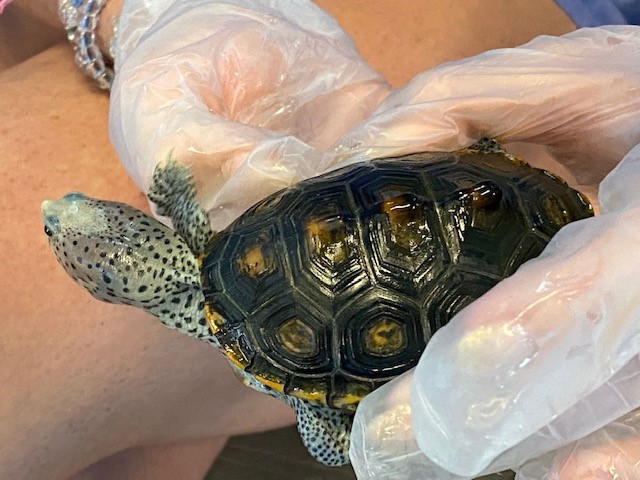
by Rick O'Connor | May 26, 2022
As the Sea Grant Extension Agent in Escambia County, one of my program areas is to help restore a healthy estuary. To do this we focus on educating the public how to improve water quality, restore habitat, and manage invasive species, but we also focus on how to monitor fish and wildlife. The fish and wildlife I focus on are those that were once common in the bay and are trying to make a comeback – such as scallops and horseshoe crabs. But there is another estuarine creature we are interested in that does not fall into the classic “bring them back” model and that is the estuarine turtle known as the diamondback terrapin.
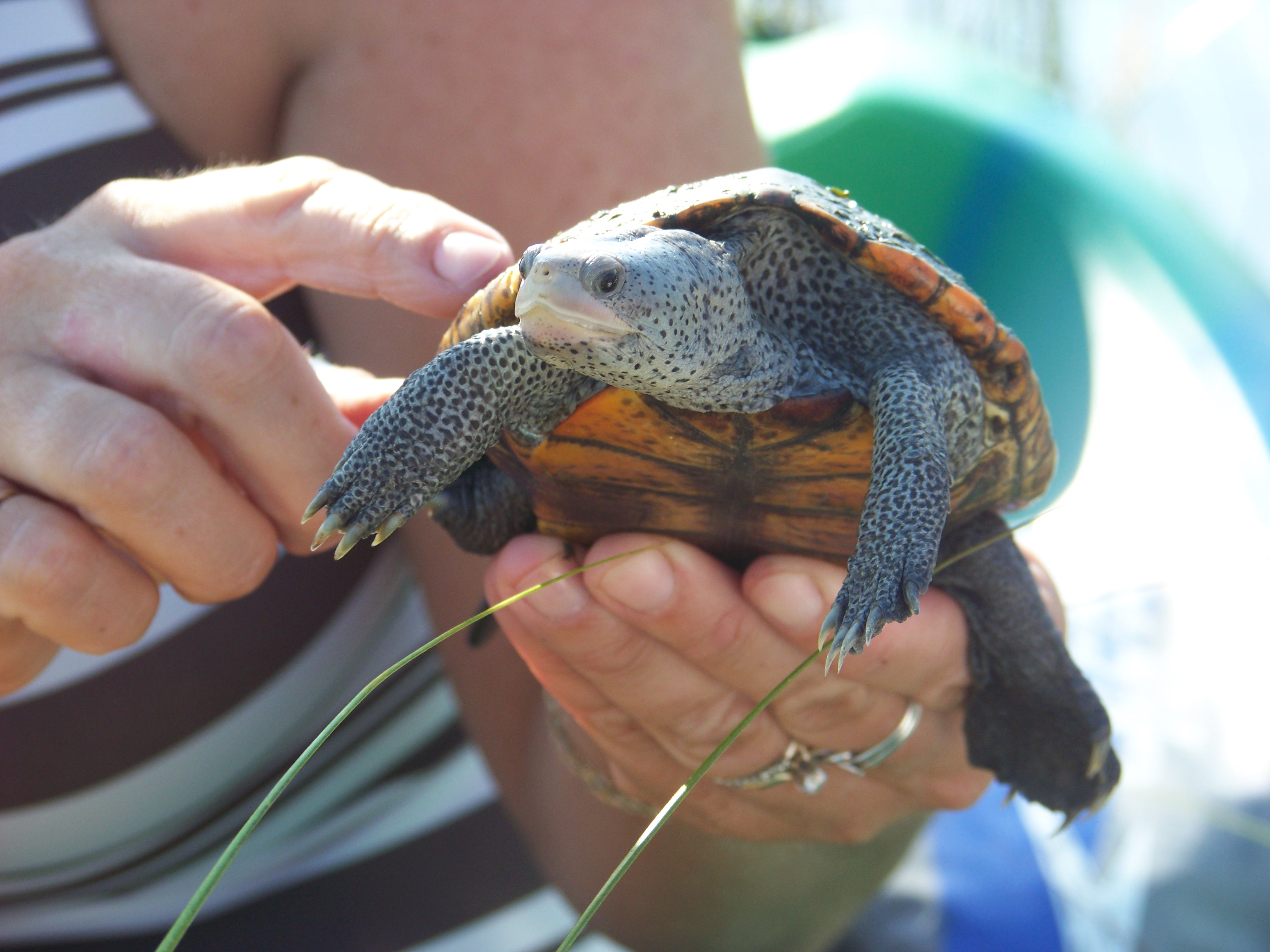
The diamondback terrapin.
Photo: Molly O’Connor
Unlike scallops and horseshoe crabs, this is not an animal that people remember as a kid. In fact, very few Floridians in the panhandle have ever heard of it. Some older distribution maps of their range show that they exist from Cape Cod MA to Brownsville TX, but with a gap in the Florida panhandle. That was because there was no scientific literature of the animal’s existence here. And that was when the Panhandle Terrapin Project began – to confirm whether or not terrapins existed here.
In 2005, working with students at Washington High School in Pensacola, we began our search by placing “Wanted Posters” at boat ramps in Escambia and Santa Rosa counties near good terrapin habitat, which is salt marsh. We began to get calls almost right away, but for a variety of other turtle species. Folks were calling us with photos of box turtles, yellow-bellied sliders, and cooters. It showed there was interest in the project but was evident they were not familiar with the terrapin.
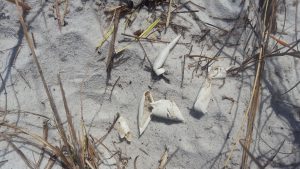
Around 80% of the terrapin nests are depredated by raccoons, or some other predator.
Photo: Bob Blais
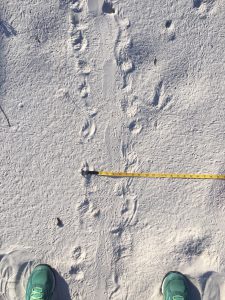
Volunteers log the number of female tracks they see on their beaches.
Photo: Cindy Marvel
I interviewed several ole gill netters to see if they remember ever capturing them – same response, “I never heard of those”. I did show one gill netter a photo and he responded – “you know, I think we did catch a couple of these”. But no confirmation of their existence here. It was time to begin searching ourselves.
The team began to survey good terrapin habitat and walking potential nesting beaches looking for any evidence. We did not find it. Then one day in 2007 a gentleman working on a construction site responded to one of our “Wanted Posters”. He said he had seen one of our terrapins. After all of the calls that led to other species, I was not so sure – but he convinced me it might be. So, we checked it out. The sign was placed in good habitat and there were potential nesting beaches nearby. We searched… and we found. What we found were nests that had been depredated by raccoons. There were empty eggshells laying around and two dead hatchlings. There were also tracks in the sand. Confirmation… there were terrapins here!
It was now time to take the show on the road and see if terrapins exist in other counties along the panhandle. My wife and I would take part of our summer vacations and camp along the coast searching. We found at least one record of a terrapin in each of the counties between the Alabama state line and Apalachicola River. All of this was presented to the Florida Diamondback Terrapin Working Group of which there are members from the Florida Fish and Wildlife Conservation Commission. Word was out.
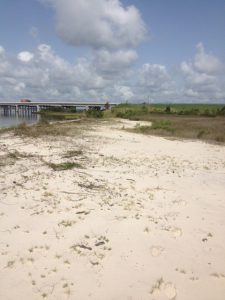
Terrapins prefer sandy beaches and lay their eggs during daylight hours.
Photo: Molly O’Connor
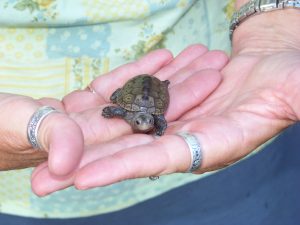
A terrapin hatchling.
Photo: Molly O’Connor
The next step was to assess their status. How many are here and how are those populations doing?
We did this by following a method developed by Tom Mann with the Mississippi Department of Wildlife. Tom was monitoring terrapins in that state and the subspecies he worked with, the Mississippi Terrapin (Malaclemys terrapin pileata) was the one that was thought to be in Pensacola Bay. So, it was Tom’s method we decided to follow. This includes walking nesting beaches and logging individual tracks and depredated nests in 16-day cycles. Tom’s model assumed that all mature females in the population nest each season and that they do not lay more than one clutch in a 16-day period. The idea is that each track and nest represented one female, and assuming the sex ratio of male to female is 1:1, doubling the number of tracks and depredated nests found in that period would give an idea of how many adult males and females are in this group. Seemed easy enough so these surveys became part of our project.
Another method learned by attending conferences was a 30-minute head count. If you can find the lagoons where the terrapins actually live you can sit and count the number of heads you see in a 30-minute period. It is true that 23 heads does not mean there are 23 terrapins, but the relative abundance can be monitored. If you typically see 20-23 heads and over time that decreases to 11-15, then the relative abundance is declining. It is a method that citizen science volunteers can do and so was included in the project.
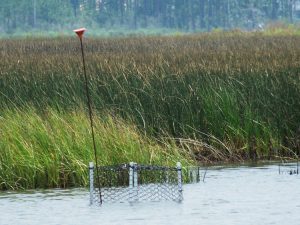
Modified crab traps is one method used to capture adults.
Photo: Molly O’Connor
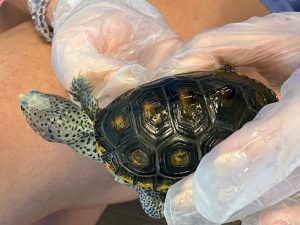
A diamondback terrapin being measured and marked before release.
Photo: Rick O’Connor
We also wanted to try and capture individuals to mark and tag. Mark recapture is a method used to estimate populations but capturing terrapins has been historically difficult to do. Several methods have been used by members of the Working Group and we have tried them as well. We have captured terrapins, but very few.
In 2018 the Team partnered with the U.S. Geological Survey to increase the robustness of the project. The Florida Fish and Wildlife Conservation Commission became interested in tissue samples from captured animal to study the genetics of the terrapins in this area. Since 2015 we have trained 228 individuals to conduct surveys, and some have been with me that entire time. Many of them have spent countless hours helping assess the status of this animal in our bays. Many days they see nothing. Others a few tracks or depredated nests. Some locations have good luck with head counts, but many of them finding nothing.
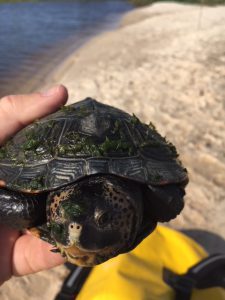
The Mississippi terrapin found in Pensacola Bay is darker in color than the Ornate terrapin found in other bays of the panhandle.
Photo: Rick O’Connor
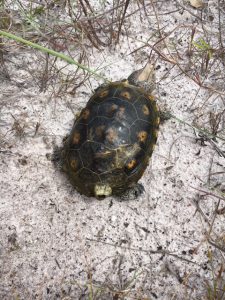
This terrapin has the coloration of the Ornate terrapin but was found much further west than the literature suggest it lives.
Photo: Rick O’Connor
I keep track of “Frequency of Occurrence” (FOO) – the number of surveys where some sort of terrapin encounter happens. This encounter can be as simple as a track in the sand, but they had SOME encounter. It is my hope that over time encounters with them will increase, just as I hope it does with scallops and horseshoe crabs. Since 2007 the FOO has ranged from 12-86% of the surveys conducted, with an average of about 25%. The best year was 2011 (86%), just after the Deepwater Horizon spill. There was a steady increase in FOO from 2007 to 2012 when it took a significant drop. However, this is not because the relative abundance of terrapins suddenly dropped. 2012 was the year I moved from the marine science program at Washington High School to Florida Sea Grant Extension. There were all new volunteers and the learning curve started over. They were not as good at detecting them as the previous group. But that is changing. 2022 is looking to be a busy year for the team.
So far this year we have seen terrapin activity on almost every nesting beach between here and Apalachicola. One site had 49 heads in a 30-minute head count! There have been several active nests, numerous tracks, and plenty of depredated nests. In addition, we have found one dead hatchling and captured two adults. Tissue from these have been collected for the genetic study. But the strangest story this year… a security guard has told us of terrapin hatchlings that have been dropped on their guard shack by birds. Sea birds are known to do this to try and crack open shells of mollusk so they can feed on them. I have never heard of this with terrapins, not here or anywhere.
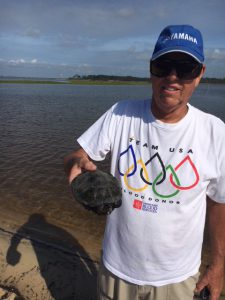
A dedicated volunteer is rewarded with a capture.
Photo: Rick O’Connor
It seems it is going to be a terrific year for the terrapin project this year. It is exciting for our volunteers to have so many encounters and nice to know that the public is becoming more familiar with this animal. I cannot say whether the population is increasing or not but our knowledge, understanding, and encounters are.
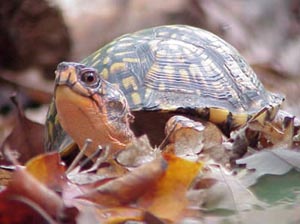
by Kalyn Waters | Apr 29, 2022

Box Turtle. Photo Credit J.D. Willson, University of Georgia
Growing up, or even as an adult there is something exciting about seeing a turtle on the road! We always want to stop and check it out or even help it across. Box Turtles are common in all parts of the southeastern United States. There are four subspecies of box turtles that can be found east of the Mississippi River. Here are three interesting topics about our common box turtles:
Reproduction
With spring in the air and the temperatures rising, they are on the move. There movement is in part due to spring being the beginning of their mating season. In the southeast males and females will mate from spring into the fall. Males will mate with one or multiple females. Amazingly females can lay fertile eggs up to four years following one successful mating! Normal incubation of the eggs typically takes three months.
Lifespan
Box turtles are well developed at birth. As soon as the hatch the start to mature and will grow at a rate of about ½ an inch per year for the first five years. While growth slows dramatically after that, they will continue to grow until they are about 20 years old. It is believed that some box turtles will live to be over 100 years old.
Home Range
While our box turtle friends live a long time, they are homebodies! Their entire home range is typically 250 yards in diameter or less. It is normal to see an overlap of home ranges for box turtles, regardless of sex or age. Keeping in mind the small home range of turtles and their limited ability to travel long distances, you should never pick them up and take them to a new area. If they are crossing a road, only set them to the other side, do not relocate them. In addition, turtles found crossing the roads in June and July are likely pregnant females. These females are likely searching for a nesting site when they are found.
As we move into spring and summer, turtles will become more active. Keep in mind that we should always leave turtles in the wild. They live longer healthier lives and can contribute to their breeding population. Likewise, you should never release a captive turtle into the wild as it will likely not survive and may introduce diseases.
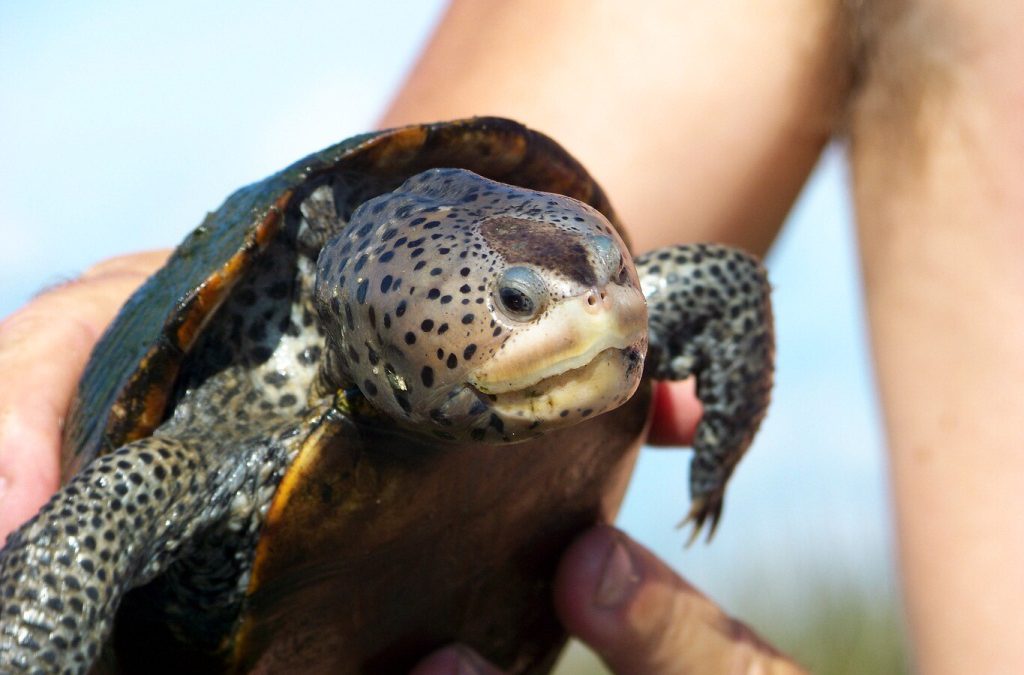
by Rick O'Connor | Apr 1, 2022
In December of 2021 the Florida Fish and Wildlife Conservation Commission (FWC) passed new regulations concerning the diamondback terrapin. One will make it illegal to possess a terrapin without a permit beginning March 1, 2022. The other will impact recreational crab trap design in early 2023. A number of people have begun to ask questions ab
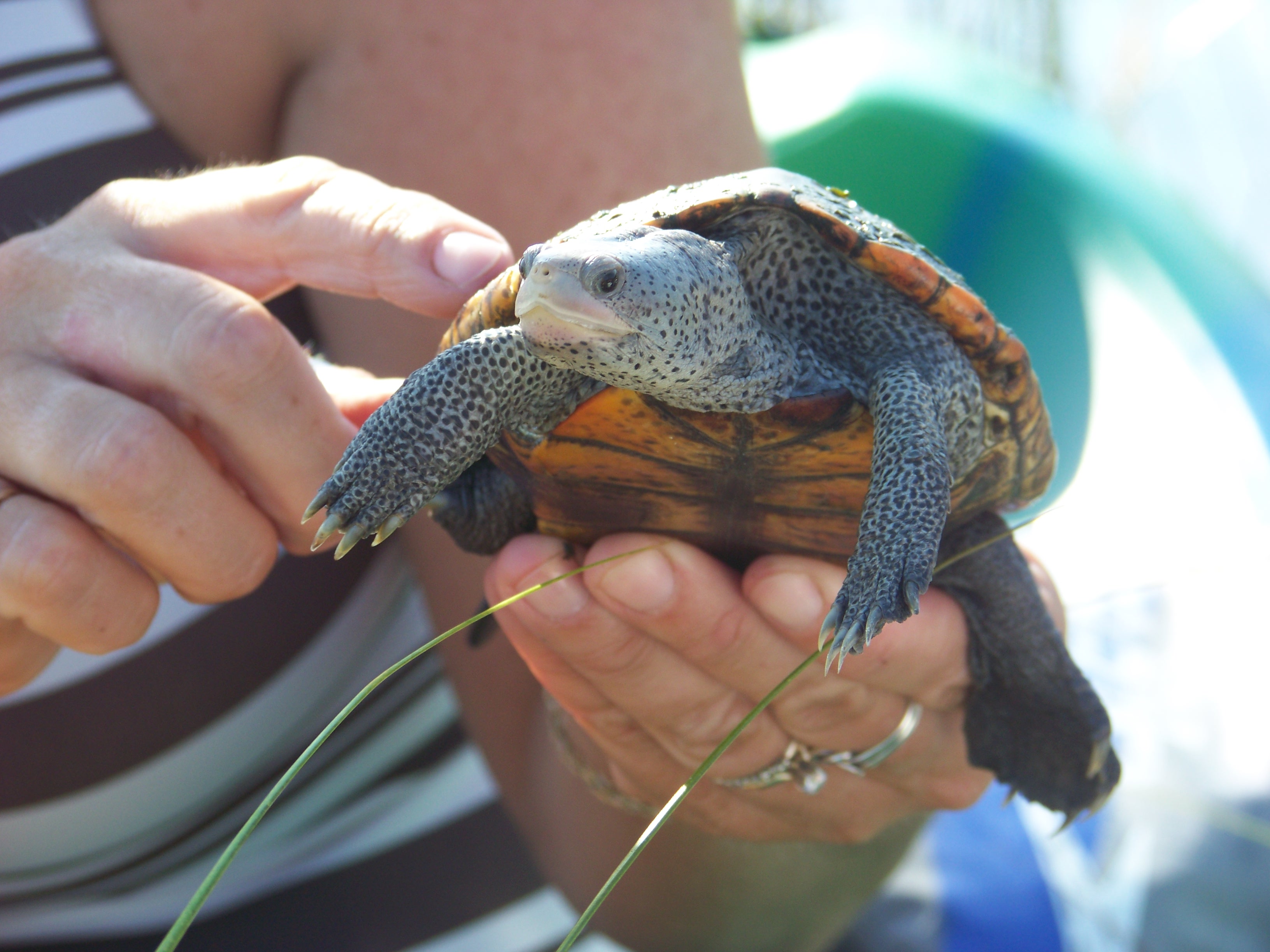
The diamond in the marsh. The diamondback terrapin.
Photo: Molly O’Connor
ut this new ruling so, we will explain it.
WHAT IS A DIAMONDBACK TERRAPIN?
We will start there. Most Floridians have never heard of this animal, and if they have, they know it from the Chesapeake Bay area. Diamondback terrapins are turtles in the Family Emydidae. This family includes many of the pond turtles Floridians are familiar with – cooters, sliders, red-belly, and others. The big difference between terrapins and pond turtles is the coloration of their skin, and their preference for brackish water – they like estuaries over ponds and lakes. They do have lachrymal glands in their eyes to help excrete salt from water, but they are not as efficient as those of sea turtles so, they cannot live in sea water for more than about a month – it is the bays and bayous they like to call home.
There are seven recognized subspecies which range from Cape Cod MA., to Brownsville TX. Five of them are found in Florida and three are only found in Florida. But few Floridians have ever heard of them and even fewer have seen one. Their cousins the pond turtles are quite common. We see their heads in ponds and lakes, several of them basking on logs near shore of ponds, lakes, and rivers, and frequently see dead ones along our highways. We don’t see terrapins. We do not see their heads in the marsh, basking on logs, or dead carcasses along our coastal highways. Again, this is an unknown turtle to us.
WHY ARE THERE NEW REGULATIONS ON A TURTLE MANY HAVE NEVER SEEN?
The question sort of explains the answer – we do not see them – their population in our state may deem some action by the FWC. In the Chesapeake region they are quite common, and people see them frequently. It is the mascot of the University of Maryland. Along the roads to the barrier islands in Georgia hundreds of terrapins can be found trying to nest and many are hit by cars. In most of these mid-Atlantic states there is some form of protection for them. They either list them as threatened or a species of concern. One state has it listed as endangered. Again, these are states where encounters are much more common.
Florida has a rich diversity of turtles, maybe the richest in the country, and we have been the target for turtle harvest. Turtles are sought after for food and as pets. The harvest of some species has been heavy and FWC has listed them as “no take”. For a variety of reasons, harvest being one of them, Alligator Snapping Turtles (Macrochelys temminckii), the Suwannee Cooter (Pseudemys suwanniensis), and the Barbour’s Map Turtle (Graptemys barbouri) are illegal to possess without a permit. This includes their eggs. Because other species look very similar to these, they have also been added to the no-take list. This would include all species of cooters and snapping turtles, the Escambia Map Turtle (Graptemys ernsti) and the Striped Mud Turtle (Kinosternon baurii) – which is a small riverine turtle that resembles a small snapping turtle. Note: the regulation on the striped mud turtle is for the lower Florida Keys only. You could take diamondback terrapins but only one and you could have no more than two in your possession. You could not possess their eggs. But with the 2021 ruling – this has changed.
As mentioned, terrapin encounters are rare in our state. There has been concern about their population status here. I got involved with them in 2005 primarily to answer the question “Do terrapins even exist in the Florida panhandle?”. The answer is yes, they do. Since 2005 myself, and trained volunteers, have conducted 859 surveys searching for them between Escambia and Franklin counties. We have encountered terrapins, or terrapin sign (tracks, shells, depredated nests) 215 of those – 25% of the surveys; most of those encounters were terrapin sign – they are hard creatures to find. Because of the low encounter rate across the state, it is believed that the populations here are low and in need for conservation measures.
Then comes the crab traps…
Researchers with the Diamondback Terrapin Working Group have identified several stressors to terrapin populations. Loss of habitat, depredated nests by predators (particularly the raccoon), road mortality, and… crab traps. Terrapins feed primarily on shellfish but will eat other things if given the opportunity. They do have a tendency to enter crab traps. Though they feed on small juvenile crabs it is the bait we think they are after in this scenario. Once in, like blue crabs, they find it hard to escape. Unlike blue crabs, turtles have lungs, and the terrapins eventually drown. In the Chesapeake Bay region blue crabs are ”king” – a major commercial and recreational fishery. Terrapins entering crab traps means crabs are not. There have been as many as 40 dead terrapins found in one trap. This was a major concern for all. Dr. Roger Woods of the Wetlands Institute in New Jersey began working on a device that would keep terrapins out but allow blue crabs in. Data shows that in most cases, the larger females are the ones entering and the smaller males would follow. If you could keep the female out it was believed that most males would not enter. So, the device was designed to keep the large females out. A 6×2” rectangle seemed to work best. Field studies showed that these By-Catch Reduction Devices (BRDs) kept 80-90% of the terrapins out and did not significantly impact the crab catch. We had a design that seemed to work.
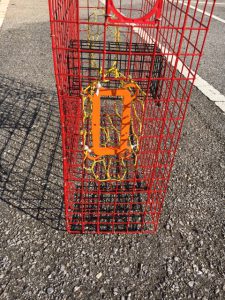
This orange plastic rectangle is a Bycatch Reduction Device (BRD) used to keep terrapins out of crab traps – but not crabs.
Photo: Rick O’Connor
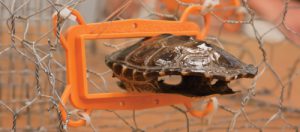
BRDs are designed to keep terrapins out but allow crabs to enter.
Photo: Virginia Sea Grant
These BRDs have been required in the Mid-Atlantic states for a few years now. With the concern in Florida populations, it is now coming to Florida. By March 1, 2023, all recreational crab traps in Florida will be required to have a fixed funnel size no larger than 6×2”. Either the funnel must be this size, or you can attach one of the plastic orange BRDs to the opening (see photo). Currently bait and tackle shops do not have the BRDs but will be acquiring over the next year. FWC will be working on providing sources between now and March of 2023. If you are in the Pensacola area you can contact me, I have a case of them in my office.
As far as having one on your possession – it is now a no-take species. This rule began March 1, 2022. If you have had a terrapin in your possession you can apply for a no-cost permit to keep it (visit the FWC link below to obtain information on applying for this permit). If you are an education facility that houses terrapins for educational purposes – the same, you can apply for a no-cost education permit to keep your terrapins. You must have this permit by May 31, 2022.
If you have any questions concerning this ruling or how to comply with it, you can contact FWC or your county Sea Grant Extension Agent. The FWC link for more information on this, and other turtle regulations, can be found at https://myfwc.com/wildlifehabitats/wildlife/freshwater-turtles/?redirect=freshwaterturtles&utm_content=&utm_medium=email&utm_name=&utm_source=govdelivery&utm_term=campaign.
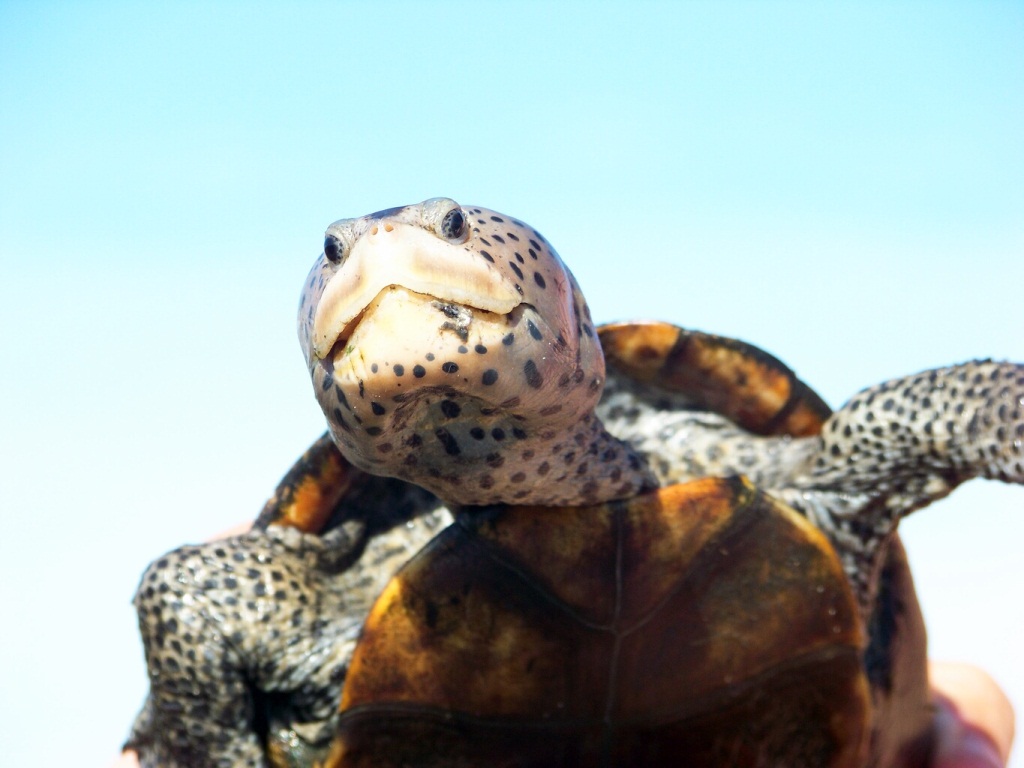
by Rick O'Connor | Mar 11, 2022
Let’s begin by stating what a diamondback terrapin is. I have found many Floridians are not familiar with the animal. It is a turtle. A turtle in the family Emydidae which includes the pond turtles, such as cooters and sliders. The big difference between terrapins and the other emydid turtles is their preference for salt water. They are not marine turtles but rather estuarine – they like brackish water.
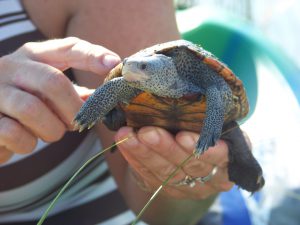
The diamond in the marsh. The diamondback terrapin.
Photo: Molly O’Connor
Their haunt are the salt marshes and mangroves of the state. Their range extends from Massachusetts down the east coast and covering all of the Gulf of Mexico over to Brownsville Texas. There are seven subspecies of the animal within that range. Five of those live in Florida and three only live in Florida. They are more abundant, and well known, in the Chesapeake Bay area where they are the mascot of the University of Maryland. In Florida they seem to be more secretive and hidden. Encounters with them are rare and there has been concern about their status for years. Though researchers are not 100% sure on their population size, it was felt that more conservation measures were needed.
Ten years ago, the issue with all turtles in the state was the illegal harvest for the food trade. All sorts of species were being captured and sent to markets overseas. The Florida Fish and Wildlife Conservation Commission (FWC) stepped in and set possession quotas on many species of Florida turtles. For terrapins, the number was two. For some, like the Suwannee Cooter, there was a no possession rule.
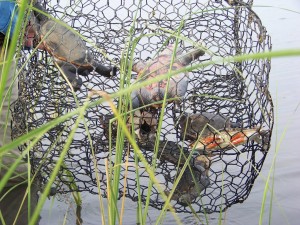
Drowned terrapins in a derelict crab trap in the Florida panhandle. (photo: Molly O’Connor)
There has also been concern with incidental capture of terrapins in crab traps. These turtles have been known to swim into the traps and drown. In the Chesapeake Bay area, they have found as many as 40 dead turtles in one trap. Not only is this bad for the turtles, but it is also bad for the crab fisherman because high numbers of dead turtles in the trap means no crabs. Studies began to develop some sort of excluder device that would keep terrapins out, but allow crabs in. Dr. Roger Wood developed a rectangle shaped wire excluder now called a By-Catch Reduction Device (BRD) that reduced the terrapin capture by 80-90% but had no significant effect on the crab catch. That was what they were looking for. This BRD has been required on crab traps up there for years.
What about Florida?
Studies using the BRD were also conducted here with the same results, but the BRD was not required. Incidental capture in crab traps does occur here but not to the extent it was happening in the Chesapeake and FWC wanted to hold off for more science before enacting the rule. BRDs were available for those who wanted them, but not required. This past December (2021) that changed.

This orange plastic rectangle is a Bycatch Reduction Device (BRD) used to keep terrapins out of crab traps – but not crabs.
Photo: Rick O’Connor
In recent years there has been another issue with harvesting terrapins for the pet trade. With this, and other conservation concerns for this turtle, FWC developed a new rule for terrapins at their December 2021 meeting.
- The possession limit for terrapins has dropped from 2 to 0 – there is a no-take rule for this animal beginning March 1, 2022. Collection for scientific research will still be allowed with a valid collecting permit from the FWC. Those who currently have two or less terrapins in their possession as pets may keep them but must obtain a no cost personal possession permit to do so by May 31, 2022. Those who have terrapins within an education center may keep them but must obtain a no cost exhibit permit by May 31, 2022.
- Recreational crab traps will require the BRD device by March 1, 2023. You have a year. Those in the Pensacola area can contact me for these. I have a case of them I am willing to provide to the public.
Again, studies have shown that these BRDs do not significantly impact the crab catch. Crabs can turn sideways and still enter the traps. But reducing incidental capture of terrapins will hopefully increase their numbers in our state. For information on how to obtain the needed permits visit FWC.
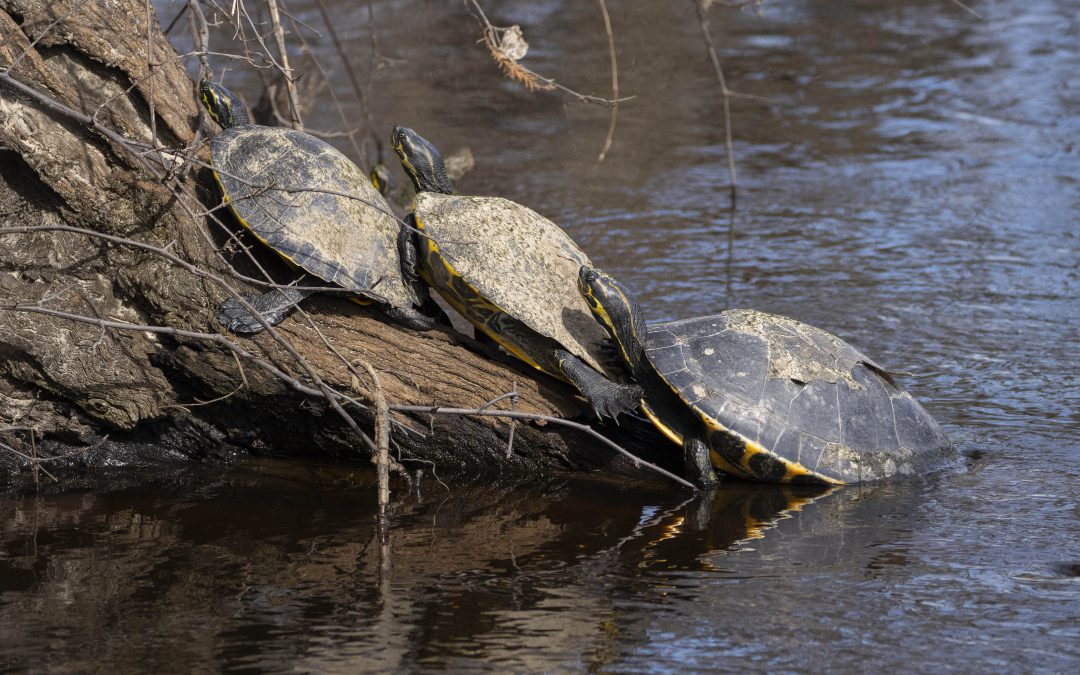
by Erik Lovestrand | Jun 3, 2021
Identifying North Florida river turtles can be quite challenging, given the fact that several species are collectively referred to as “streak-ed heads” by many people. Although you will not find this term in the scientific naming conventions, it is actually an apt description for many turtles in the Southeast that have dark skin with thin, yellow pinstripes on their head and neck. North Florida has at least half a dozen species that fall into this general grouping. They include the Suwannee cooter, river cooter, Florida cooter, chicken turtle, yellow-bellied slider and a couple of map turtles. We even have a disjunct population of Florida red-bellied turtles on the Apalachicola River that are isolated from the main group, which is restricted to peninsular Florida and extreme Southeastern Georgia. Overall, we have about 25 species of turtles in Florida.
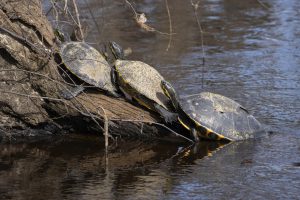
Suwannee cooters at Lafayette Blue Springs, Lafayette County, Florida, 2021.
FWC Photo by Andy Wraithmell
As you might guess, the key to accurate river turtle identification lies in the details and the details can be tough to see. Most basking turtles tend to tumble off their logs into the water long before you are close enough to scrutinize their features. However, a few tips and tricks may improve your chances when going afield. A good pair of binoculars and a reptile field guide are must-haves. You need to be able to see if the yellow on the side of the head is a wide splash (as on the yellow-bellied slider), or a series of thin lines (as on various cooters). If the top shell (carapace) is very dark and the bottom shell (plastron) shows orange color, you might have a red-belly or Suwannee cooter (higher dome on red-belly, relatively). Two of our native species have what are referred to as “striped breeches”. When viewed from the rear, the stripes on the hind legs are vertically oriented on the yellow-bellied slider and the Florida chicken turtle. The chicken turtle is distinguished by a relatively narrower head and a wide, yellow stripe on the front legs. Separating the various cooter species gets a little trickier. You need to use characteristics like the pattern on the plastron, the occurrence of “hairpin-shaped” stripes on the head, or the pattern of lines on particular carapace scutes.
So how do you get those clues in the wild? A good telephoto lens may work if you are fortunate enough to own one. This will give you the opportunity to study detailed features at your leisure. Otherwise, you may not be able to identify a turtle to the species level. Getting close to a wary turtle is not easy. However, on busy stretches of our waterways, where wildlife are desensitized to people and boats, turtles generally have a wider comfort zone. Especially if you are in a canoe or kayak and minimize your movement and sound as you glide in for a better view. Lastly, go looking on a bright sunny day and your opportunities will vastly increase as turtles climb out of the water onto logs to soak up some of that good old Florida sunshine. One species that you should have no trouble naming when encountered, is the softshell turtle. Softshells will extend their extremely long neck upward when basking and their flexible, smooth shell will appear flattened in profile. They are the only turtles here with a tubular snout. Never try to pick one up if encountered crossing a road, as they do not hesitate to bite and have extremely sharp and powerful jaws. In general, even if you are confident in not getting nailed, you will probably be wrong, given the extremely long neck that can reach more than halfway back on the shell. Also, all of our water turtles have very sharp claws on their hind feet and will manage to get in a few good rakes before you decide to put them down, or worse yet, drop them on the pavement and injure them.
Now, when you think you are getting good at basking turtle identification, start looking for some of our less obvious, smaller species. These include stinkpots, musk turtles, mud turtles, map turtles and box turtles; all very cool critters. But if you think you want to pick up one of the cute little buggers, beware. Most of the little ones will bite too…hard! Believe me. Happy “turtling!”
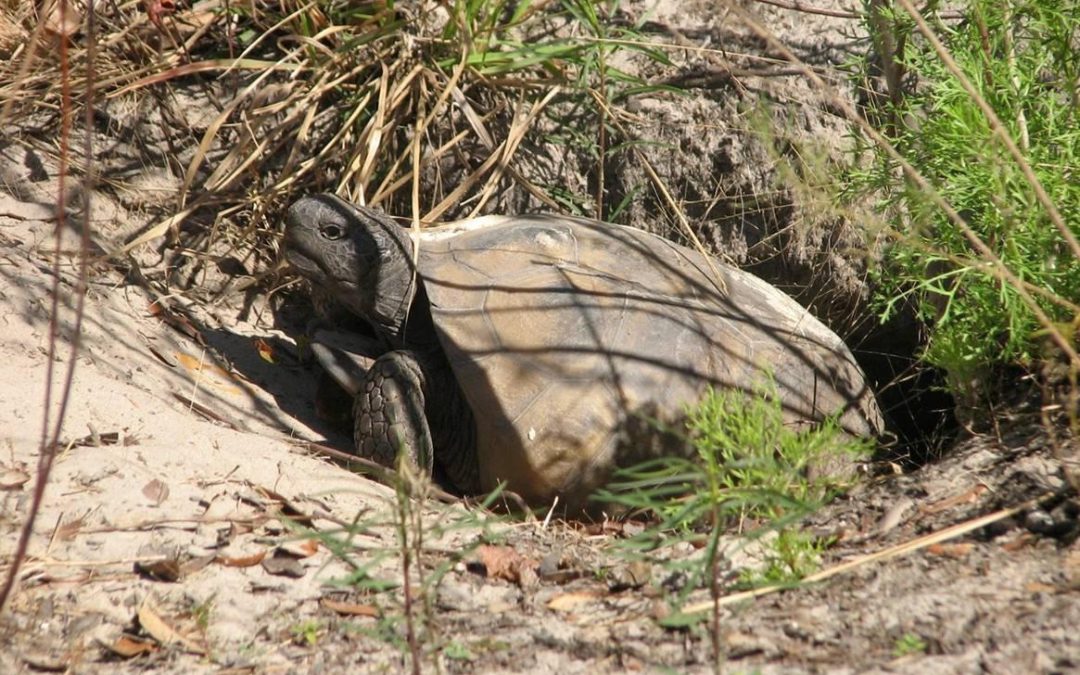
by Rick O'Connor | Jul 16, 2020
This blog will wrap up our series on Florida turtles for the Year of the Turtle (2020) – and we end with a good one – the gopher tortoise. We only have two true terrestrial species of turtles in Florida, and it does not get more terrestrial than the gopher tortoise.
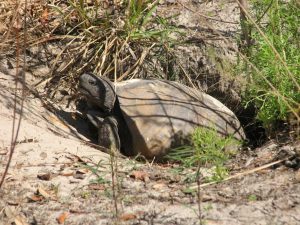
Gopher tortoises are long-lived, protected by their thick shells and deep burrows. Photo credit: Carrie Stevenson, UF IFAS Extension
“Gophers” (Gopherus polyphemus) are well known to many ole timers because they like the same type of habitat the earlier settlers did – high dry ground. They are indigenous to the southeast United States and prefer the open canopy of pine forest habitat. As a kid our home was on such a place in an area of Pensacola called Scenic Heights. Our house was on a “sand hill” that had pine and turkey oak trees. There were a variety of grasses and legumes growing everywhere and the soil was very dry and sandy. And we had gopher tortoise. The famous 18th century traveler/botanist, William Bartram, described this animal several times during his travels across the southeast as he crossed “sand hills” within the massive expanse of pine forest that were here at that time.
Though a forest, the longleaf pine forest of the southeast had a more open canopy allowing the growth of a variety of grasses to do well on the forest floor – as they did at my house. Tortoises are vegetarians, eating a variety of these grasses, flowers, and ground fruit. They like the young tender shoots of these plants and they were maintained those decades ago by natural wildfires started by lighting. The small fires would burn the large, tough plants down, providing the young tender shoots the tortoises prefer.
If you see a tortoise, you will notice the large square shaped shell and the elephant-like feet – definitely not a water turtle. They dig burrows in this sandy soil in which they can live during the hot days of summer and the cold days of winter. These burrows can be quite extensive – reaching a length of over 15 feet and a depth of up to 7 feet from the surface. Though the literature will tell you that they prefer dry sandy soils for digging, they have been found digging in the red clay of the southeast as well. However, these burrows are generally not as deep because the O2 levels decline and the CO2 concentrations increase significantly in clay soils. There is only one entrance to the burrow, and it has been said that gophers can dig down – but not up.

Gopher tortoises are nesting right now–be sure to observe from a distance!
It is generally one tortoise to a burrow, but some will dig a second burrow within their range as a “back-up” during pop up thunderstorms and such. It is not uncommon to find 2-3 tortoises sharing he entrance of a burrow during stressful moments – or during mating of course. The temperatures within are nice a cool during the summer – ranging from 60 – 72°F. This “air conditioned” hide away has become popular with many other creatures of the pine forest. Over 350 species of them have been known to share the burrow. Most of these are insects but a few vertebrates are known to call including – the gopher frog, mice, the endangered eastern indigo snake, and the eastern diamondback rattlesnake. Most of these animals use the burrow during extreme conditions – heavy rain, intense heat or cold, or during a forest fire. The rattlesnakes tend to sit near the entrance and so observers should beware of sticking their face or hand into the opening looking for a turtle. Many field workers will use a small hand mirror to look into the opening. Either you see the rattlesnake, or, the reflection of sunlight into the burrow will cause the snake to rattle – altering you they are there.
Terrestrial turtles produce fewer young than aquatic species. Gophers will typically produce 5-9 eggs once a year. The eggs are usually buried within the “apron” of the burrow – this is the field of sand discarded while digging. There is a projection from the anterior end of the plastron called a gular. This projection is much longer in males and can be used in jousting matches with other males. Males will also have a concave depression from the midpoint to the posterior end of the plastron. Though mating can occur any time of year – most activity is from May to July.

A terrestrial gopher tortoise crossing the sand on Pensacola Beach.
Photo: DJ Zemenick
These animals have declined across their range. They have the typical turtle egg raiders (raccoons, fox, skunks, and opossums) but now have threats from invasive species such as tegus and fire ants. Hatchlings and juveniles have soft shells and are easy targets. Coyotes have been seen hiding behind burrows flipping the emerging tortoise and then consuming it. However, man has been a problem as well.
Food was one problem, and apparently still is in some parts of the south. These animals were “noosed” from their burrows and cooked. During the depression era they were known as “Hoover’s Chicken”. As mentioned at the beginning – they live where we want to live. Construction crews come in and cover “entomb” them during development projects. It is now against Florida law and crews must relocate them.
In natural areas, the suppression of natural wildfires as altered the ecology enough that food for the gophers has become an issue. As they abandon their burrows seeking better spots, they are preyed upon, run over by cars, attacked by dogs, the list goes on. In recent years, an upper respiratory tract disease has proven to be common and deadly.
Today the animal is federally protected in Louisiana, Mississippi, and western Alabama. It is species of concern throughout its range and is a state threatened species in Florida. You cannot possess this animal but having one move into your yard is fine.

This gopher tortoise was found in a dune field; a place where they have historically been found.
Photo: DJ Zemenick
I hope you enjoyed this series on Florida turtles, during the YEAR OF THE TURTLE. You can find more blogs on other species by visiting the natural resource page of the Escambia County Extension website and type in which species you are looking for in the “what can we help you with?” search tool at the top of the page. https://sfyl.ifas.ufl.edu/escambia/?topic=natural-resources#county-feed.
I hope you are lucky enough to find all 25 species in the wild.


























